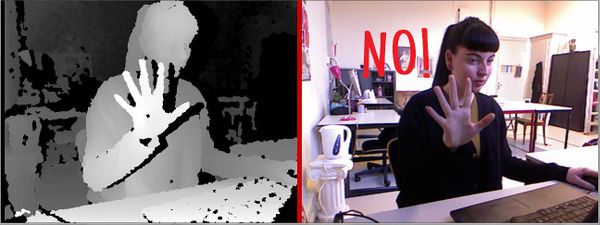Editing - Narrative: Difference between revisions
(Created page with "== Prototyping Editing/Narrative == Connecting the Kinect to the book ‘''The Society of the Spectacle''’ from Guy Debord. Not the whole book, but a part of the book. As r...") |
No edit summary |
||
| Line 15: | Line 15: | ||
http://en.wikipedia.org/wiki/Kinect | http://en.wikipedia.org/wiki/Kinect | ||
[[File:Kinect.JPG|600px|thumb|right]] | |||
Revision as of 19:13, 10 February 2015
Prototyping Editing/Narrative
Connecting the Kinect to the book ‘The Society of the Spectacle’ from Guy Debord. Not the whole book, but a part of the book. As research I want to see the different with the movie and the book. Because Debord talks about that people are mediated by images, but the movie is also an images based media. So what does that say about the text and the movie? Maybe I have to re-editing the movie of Debord.
The other part of my research is the Kinect. I going to focus on one sensor and going to prototype them and lastly I’m going to connect the text with the technical part. At the end I also have to think about how people react to it, and how the engaged to the work. The following features as Kinect can provide on a Windows:
1. Raw sensor streams: Access to low-level streams from the depth sensor, color camera sensor, and four-element microphone array.
2. Skeletal tracking: The capability to track the skeleton image of one or two people moving within Kinect's field of view for gesture-driven applications.
3. Advanced audio capabilities: Audio processing capabilities include sophisticated acoustic noise suppression and echo cancellation, beam formation to identify the current sound source, and integration withWindows speech recognition API.
4. Sample code and Documentation
http://en.wikipedia.org/wiki/Kinect
How to:
http://kin-educate.blogspot.nl/2012/06/speech-recognition-for-kinect-easy-way.html
https://gist.github.com/elbruno/e4816d4d5a59a3b159eb#file-elbrunokw4v2speech
https://raychambers.wordpress.com/2011/12/31/lesson-9kinect-speech-recognition/
http://wiki.roberttwomey.com/UNTREF_Speech_Workshop#Hands-on_with_Sphinx4_Library_for_Processing
http://learning.codasign.com/index.php?title=Trigger_Audio_When_a_Skeleton_is_Tracked
SPEECH TO TEXT LIBRARY - http://florianschulz.info/stt/
http://ericmedine.com/tutorials/LECTURE_kinect_hacking.htm
Kinect
Let’s not focus too much on the tool but on the concept. The Kinect is not working out for me, so I want to focus more on the book and the movie of Debord. How can I make people engage with ‘The Society of the Spectacle’, to let them be aware of it or to understand it? Do we look different at an image or movie when we have read the text of Debord? Maybe video is not the right medium, and I have to incorporate physical objects to. And why the hole movie or book, and not choice just one part because it’s complicated enough.
For me the best part of the book is when he talks about:
Mass media and commodity fetishism
The Society of the Spectacle is a critique of contemporary consumer culture and commodity fetishism. Before the term "globalization" was popularized, Debord was arguing about issues such as class alienation, cultural homogenization, and the mass media.
When Debord says that “All that was once directly lived has become mere representation,” he is referring to the central importance of the image in contemporary society. Images, Debord says, have supplanted genuine human interaction. (Thesis 1)
Thus, Debord’s fourth thesis is: "The spectacle is not a collection of images; rather, it is a social relationship between people that is mediated by images." (Thesis 4)
In a consumer society, social life is not about living, but about having; the spectacle uses the image to convey what people need and must have. Consequently, social life moves further, leaving a state of "having" and proceeding into a state of "appearing"; namely the appearance of the image. (Thesis 17)
"In a world which really is topsy-turvy, the true is a moment of the false". (Thesis 9)

